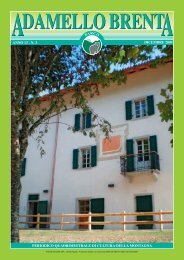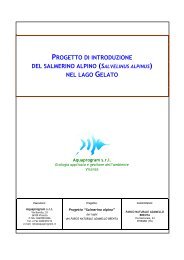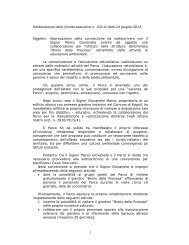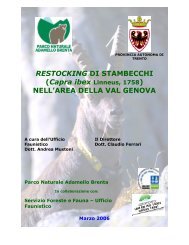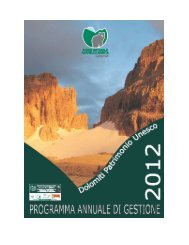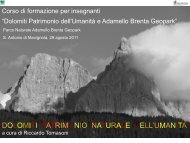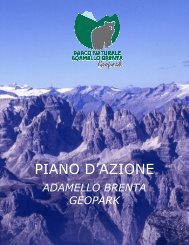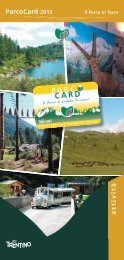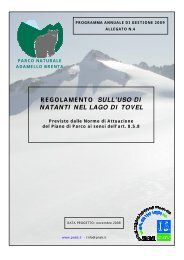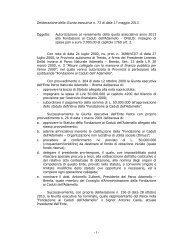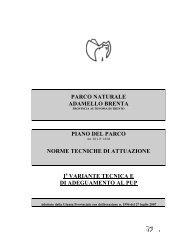DAMELLO BRENT A A - Parco Naturale Adamello Brenta
DAMELLO BRENT A A - Parco Naturale Adamello Brenta
DAMELLO BRENT A A - Parco Naturale Adamello Brenta
You also want an ePaper? Increase the reach of your titles
YUMPU automatically turns print PDFs into web optimized ePapers that Google loves.
War cemetery at 2445 m of altitude – Photo M. Magnai Old glassworks in Carisolo – Photo R. Tomasoni<br />
34<br />
sulphides andthe existing galleries are<br />
evidence of a good mining activity, of<br />
ancient origins, that involved the right<br />
orographic side of Val Rendena (from<br />
Mortaso to the further areas near the<br />
Village of Verdesina).<br />
Inside the territory of the future Geopark<br />
there is other evidence of mining<br />
activity in Val di Breguzzo, Val<br />
Daone, and on the right orographic<br />
side of Val Rendena between Bocenago<br />
and Mortaso.<br />
Old Glassworks in Carisolo<br />
During the 1800s there were three<br />
Glassworks in the Giudicarie: the Bormioli<br />
and Garuti Glassworks in Val d’<br />
Algone, the Pernici and Bolognini<br />
“Glass Industry ” in Carisolo and the<br />
Venini glassworks in Tione. It was a<br />
flourishing and renowned industry that<br />
A <strong>DAMELLO</strong> <strong>BRENT</strong>A<br />
GeoPark<br />
produced sheets of glass for windows,<br />
bottles and, in the Glassworks of<br />
Carisolo, precious Boehmian Glasse,<br />
exporting their products to northern<br />
Italy and northern Europe. The Valli<br />
Giudicarie had all the requirements<br />
for glass production: a subsurface<br />
rich in precious quartz, an essential<br />
element for the production of the glass<br />
pulp; woods for supplying of the fuel;<br />
abundant flowing water used to drive<br />
the big hydraulic wheels of the quartz<br />
mills and sawmills.<br />
The Pernici e Bolognini (1805-1888)<br />
Glass Industry, located in Carisolo,<br />
employed about 70 people: quartz<br />
crushers, woodcutters, and master<br />
glassmakers from Bohemia and Alsatia,<br />
apprentices and maintenance. The<br />
production plant was like a small village,<br />
with the big “Halle” where the<br />
furnace was located with its impressive<br />
smokestack; the worker’s lodging;<br />
the “colombera”, were the offices<br />
were located; the country house;<br />
sheds and stables; the “venetian” sawmill,<br />
and the quartz mill.<br />
The minerals came from the mines of<br />
Borzago and Giustino, and were carried<br />
on mules or sledges. They were<br />
crushed in the impressive granite<br />
mill to produce the raw material for<br />
the production of the glass pulp. The<br />
Glasswork’s activity lasted about one<br />
century, representing an illuminating<br />
entrepreneurial example that transformed<br />
an isolated community into<br />
an open minded multicultural world.<br />
Testimony that particular period includes:<br />
the ruined smokestack of the<br />
Val d’Algone Glassworks and the<br />
“Fabrica Cristallorum” structure near<br />
Carisolo.<br />
Corno di Cavento<br />
The Corno di Cavento, climbed for<br />
the first time in 1868 by J. Payer,<br />
the first climber of <strong>Adamello</strong>, is a<br />
peak of 3402 m in height. It is on<br />
the N-S ridge, whose highest peak is<br />
the 3462 m high Cima Carè Alto,<br />
located in the <strong>Adamello</strong> Range.<br />
The great importance of Corno di<br />
Cavento is its historic role. During<br />
the First World War (1915-1918),<br />
it was the battlefield, as was most<br />
of the <strong>Adamello</strong>-Presanella Range,<br />
of hard combat between the Alpini<br />
and the Kaiserjaeger (the Italian and<br />
Austro-Hungarian mountain troops).<br />
This war is referred to as the “White<br />
War”.<br />
APPLICATION DOSSIER FOR THE NOMINATION AS EUROPEAN AND GLOBAL UNESCO GEOPARK<br />
Old glassworks in Val Algone – Photo Bosetti



